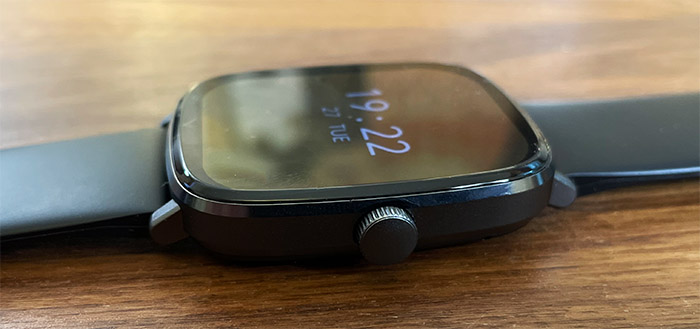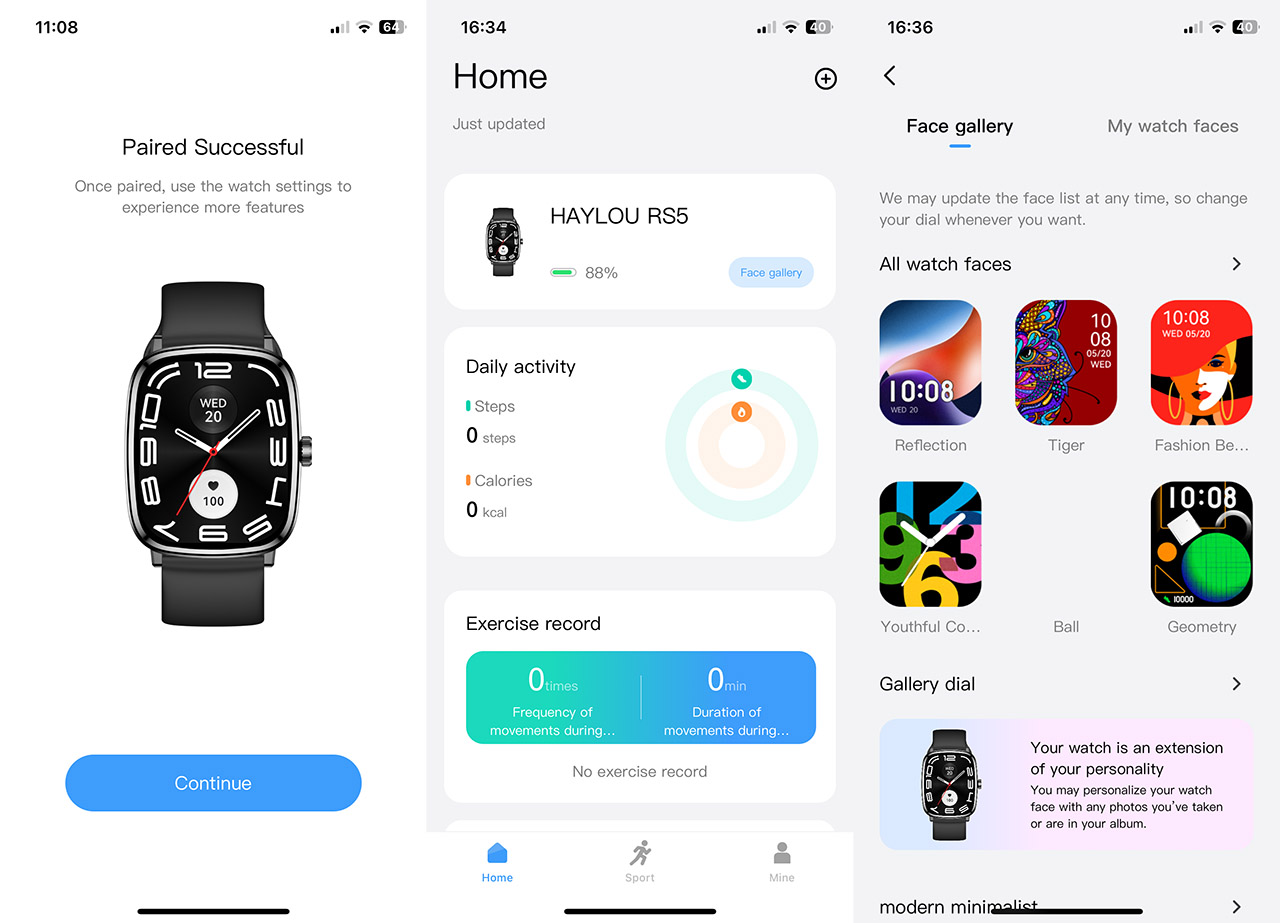Haylou is once again pushing the boundaries to how a budget-friendly smartwatch should look and operate, this time by releasing the Haylou RS5. At first glance, the smartwatch doesn’t look that much different than the S8 or the devices from the Solar series, but turn on the display and you’ll see the difference.
| Haylou RS5 | |
|---|---|
| Haylou.com | Check Product |
| Aliexpress.com | Check Product |
Yes, it’s still AMOLED, but the display is bigger and brighter, now also having a refresh of 60Hz. Additionally, the manufacturer seems to have experimented a bit with a AoD implementation, but we will see how well it turned out during our tests.

And the build quality of the Haylou RS5 seems to have also been elevated, adding metallic elements, but the case remains lightweight enough to feel comfortable on the hand. Software-wise, it’s very similar to the other Haylou smartwatches and to pretty much all budget-friendly brands out there. It’s a very lightweight OS which is closed source and designed to draw as little power as possible, while also providing a fairly decent experience.
It’s nothing like the WearOS, but do you actually need it to be? It’s a sacrifice that unfortunately needs to be done to gain a better battery life. And yes, the Haylou RS5 is advertised as being able to reach up to 9 days with normal use. All of this sounds exciting, but at this price point, there has to be a catch, right? Let’s find out.
The Design and Build Quality
if you’re familiar with the RS4, then know that the Haylou RS5 is very similar in terms of design. It has a rectangular case with a flat display at the top and on the side, there is a crown that can be used for navigating the OS.

And considering the price tag of the smartwatch, one would expect an all-plastic-build, but that’s not really the case here. Haylou went with what they call an aircraft-grade metal frame and it’s fairly sturdy, but yes, the bottom panel is made of plastic, although a solid piece nevertheless. Within the frame, we can see the two speaker openings on the left side, while the microphone hole sits on the right side, next to the crown.
I was impressed by the smoothness of the crown found on the on the Haylou S8, but the developers went with a different piece when they built the RS5. It’s not bad or anything, just that the crown is not as smooth, requiring a tiny bit more force to move it. So not as satisfying as on the S8, but still fair enough for a budget-friendly smartwatch. Can you use the Haylou RS5 by only operating the crown? It is possible to enable the menu and scroll through the options, but you still need to tap on the display to enter a certain section.

So no, it’s a combination between the crown and the display (you can operate the smartwatch entirely using the latter approach). On the rear panel, there is a circular bump where you can see the heart rate sensing area. A bit above it, there are two magnetic pins and I was surprised to see that the charging cable from the S8 was the same as the one for the RS5. This means that the manufacturers finally made the minimum effort to at least keep one charger per smartwatch brand? Oh, sweet summer child.
Of course not, despite the two charging cables being essentially identical, you can’t charge the Haylou RS5 with the cable from the S8. We need to grow the landfills! Anyway.. let’s see if the straps are comfortable. Haylou went with a pair of silicone straps which are soft to the touch and the locking mechanism is the universal type which means that you can easily replace them. Additionally, there is another strap in the package, a green textile one which uses Velcro and I suppose it does sit better on the wrist, but it may not be on everybody’s taste.

I assume it’s a way to say that the Haylou RS5 is suitable for outdoor adventures and I don’t deny the sturdiness of the frame, just that the display is a bit vulnerable to mechanical shocks, so be careful with it.
The Display
The Haylou RS5 has a 2.01-inch AMOLED display and it seems that the resolution is 410×502 pixels (may be corrected), so, besides the size, it doesn’t differ that much from what we saw on the S8 and Solar Plus.
The blacks are fairly deep and thew whites are clean, without any color shifts, but I am not sure about the resolution because the text seemed crispier on the S8. So the 410x502p is strangely not enough. In terms of brightness, the display can get overwhelmingly bright, so you will absolutely be able to see what’s going on when it’s very sunny outside (such as on the beach). It is going to have an impact on the battery life, so but it’s worth it. Now let’s talk a bit about the Always on Display.

This is the first time I see that Haylou gets serious about implementing AoD and it looks very nice, showing the time in the middle with the date underneath. You can also go for the analogue look as well. I am not entirely sure whether the display allows them to simply enable some pixels and not have to keep all of it on since it will be a battery hog. And unless my eyes deceive me, this is indeed the case because the screen appears to be turned off all around the time display.
Now let’s talk about the 60Hz refresh rate. Wasn’t this the standard rate? I assumed so, but that’s not necessarily the case. Sure, anything above 200 dollars will have 50 or 60Hz panels, but not many entry-level smartwatches do. Which is why it’s a welcomed addition. The issue is that maybe the hardware is not strong enough to handle it because navigating the OS is not as smooth as I would have liked.

The Internal Hardware and Connectivity
The Haylou RS5 is very new to the market (at the moment of writing), so the FCC ID page is not yet populated and this means that I couldn’t see the main components. But Haylou still made available some info. We know that the smartwatch is equipped with 16MB of flash memory and 304kB of MCU (RAM). I don’t yet know anything about the SoC, but again, Haylou has mentioned the support for Bluetooth 5.2.
This means that the coverage is about 30 feet with the usual amount of interference found in a home (walls and such) and this is the medium through which the Haylou RS5 communicates with the smartphone (including the Bluetooth calls). It’s interesting to see that the S8 uses Bluetooth 5.3, not that it changes anything in terms of bandwidth or coverage.
Are the sensors accurate?
The Workout section from the OS is very well populated with lots of options to choose from. And in terms of sensors, the Haylou RS5 is equipped with an STK8325 gravity sensor, a VC30F heart rate sensor (compatible with V9201) which also works for detecting the blood oxygen level.

But how accurate is it while working out? It depends on the type of sport you’re doing. For example, I noticed that if I started slow and then I did cardio for half an hour, the heart rate sensor was decently accurate at showing the mild fluctuations. But with body building, it struggled a lot because the HR tends to rise and fall constantly. Not that I throw any shade, because not even the Amazfit T Rex 2 or the TicWatch Pro 5 managed to keep up that well.
The Mobile Application
The app that’s required for the Haylou RS5 is the Haylou Fun and the pairing involves the scanning of a QR code from the display of the smartwatch. Be aware that you can’t use the smartwatch without first pairing it to the app.

you will then be asked if you prefer to receive notifications, calls and meteorological alerts, but do be aware that each will require a specific permission to function in the background. After the pairing has been successful, you should have gained access to the Home page, where we can see the battery amount that’s left, gain quick access to the watch faces, see some Daily activity stats, Exercise records, Sleeping patterns and more.
Under Sport, you can enable a few Indoor and Outdoor activities which will then be tracked via the map (which will require permission to your precise location). Returning to the watch faces section, I could see that there are a lot to choose from and it seems that all are free. Be aware that the Sync process can take a bit before the watchface is applied.
The Software Experience
I really liked that Haylou has left out the scattered icons approach inspired by the Apple Watch and instead, we get the usual list of apps to scroll through.

As I mentioned before, although very much responsive, the transition animation is not very smooth. Perhaps it’s a RAM thing or a problem with the optimization, but I am sure it was a far better experience on the S8. That being said, it’s possible to check the Heart Rate, the Stress Level, play Music (from your smartphone) and you can also make calls if you allowed the smartwatch to access the Contacts list from your smartphone.
It’s not a standalone process, so it does require an active connection to the phone. The icons are easy to read and clear (the slightly larger screen does help) and the layout of the OS is intuitive, so there’s no chance to get confused or lost.

The Battery Life of the Haylou RS5
The Haylou RS5 is equipped with a 300mAh battery, so it’s larger than the 280mAh battery of the S8 and the manufacturer claims 9 days on normal use. If you decide to keep AoD all the time, the battery life goes down to 3 days and since I prefer both my phone and smartwatch to have the time on the screen all the time, I checked how long will the battery last. Even with a workout sessions squeezed in, I managed to get about a week with AoD, so it was quite the understatement. Overall, it’s an excellent battery life performance.
The Conclusion
The Haylou RS5 is an interesting upgrade over the RS4, offering a better display, a far more impressive battery life and a robust construction. But is it the ultimate budget-friendly smartwatch? I won’t deny that it offer a lot of value for the money, so it’s a solid choice, but I would also keep an eye on the Haylou S8 since it’s another phenomenal inexpensive smartwatch.

Mark is a graduate in Computer Science, having gathered valuable experience over the years working in IT as a programmer. Mark is also the main tech writer for MBReviews.com, covering not only his passion, the networking devices, but also other cool electronic gadgets that you may find useful for your every day life.

